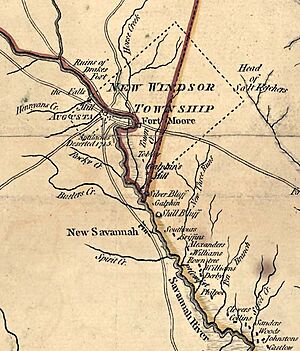Savannah Town, South Carolina facts for kids
Savannah Town, South Carolina was an old settlement that no longer exists. It was located along the Savannah River in what is now Aiken County, South Carolina. This area was important during the time when America was made up of colonies.
Around the 1670s, the Westo people had a village here. Later, a group of Shawnee people, whom the English called "Savannah," took over the area after a trade conflict. By 1685, the English knew it as Savannah Town. English traders did a big business here, trading animal skins with the Savannah Shawnee.
Savannah Town became an important frontier outpost with a fort. People could also cross the river using a ferry here. However, a new town called Augusta, Georgia was started in 1735, just five miles upriver. Augusta was closer to many Native American villages, which helped it attract more traders. This meant less business for Savannah Town. By 1740, Savannah Town was getting smaller, and by 1765, it was completely abandoned. The fort there was also closed.
Near Savannah Town was a place called Silver Bluff. From 1773 to 1775, the first separate church for Black people in the United States was formed here. Most of these members were enslaved. During the American Revolutionary War, many of them moved to Savannah, Georgia. They hoped to gain freedom from the British, who had promised it to enslaved people.
History of Savannah Town
English colonists first wrote about this area as a Westo village. They later learned that the Savannah (Shawnee) people took over from the Westo in a trade war around 1679-1680. A map from 1685 showed the settlement as Savannah Town. The growing English colony thought Savannah Town was very important. It was key for trading with Native Americans and for defending the frontier.
A busy trade grew in Savannah Town. Many traders, often from Scotland and Ireland, used horses to carry their goods. They traveled deep into Native American lands, far from the main English settlements. In 1692, the leaders of the South Carolina colony hoped traders would live in Savannah Town. By 1698, a trader named Colonel Thomas Welch even reached the Mississippi River from here. He followed a Native American trail that became known as the Upper Trading Path to the Chickasaw homeland.
Traders offered the Shawnee and other Native Americans things like iron tools and wool clothes. In return, they received thousands of animal skins, mostly deer. These skins were sent from Savannah Town in large boats called 'periagoes' (or pirogues) to Charles Town, and then shipped to Europe. To protect the area, the colonial government built Fort Moore nearby in 1715. About 25 soldiers were stationed there. In 1740, people also started a ferry service to cross the Savannah River.
The Savannah people were not happy about the English moving closer to their lands. They slowly began to leave the area. In the early 1720s, the South Carolina government invited Chickasaw people from northern Mississippi to live in the area. They hoped this would help trade and provide defense against other tribes. A Chickasaw group, led by Squirrel King, came to Savannah Town in 1723. They settled along nearby Horse Creek. These Chickasaw people worked with the English to defend the area until they returned to Mississippi around the time of the American Revolutionary War.
In 1730, South Carolina created eleven frontier townships. These were meant to protect the more developed settlements closer to the coast. Savannah Town became part of the Parish and Township of New Windsor. In 1737, about 200 settlers from Appenzell, Switzerland moved to New Windsor. Many local families today, like the Tobler, Zubly, Nagel, Sturzenegger, and Meyer families, are descendants of these Swiss settlers.
Savannah Town faced a challenge in 1735 when Augusta was founded. Augusta was just five miles upriver on the Georgia side of the Savannah River. The new Georgia Colony used Augusta's better location to its advantage. Augusta was closer to most Native American settlements, which helped it attract more traders. Georgia also worked to send all the trade goods to its own port city of Savannah on the Atlantic coast.
By 1740, the future of Savannah Town was uncertain. During the Cherokee War of 1760, Fort Moore provided shelter for soldiers and people seeking safety. However, by 1765, Savannah Town had mostly disappeared, and the fort was closed for good.
Where Savannah Town Was
Savannah Town was also called Savano Town, Savanaton, or Old Savannah. It was located at 33°26'18"N, 81°54'32"W. This spot was about 225 river miles upstream from the port city of Savannah. Today, the closest town is Beech Island, South Carolina. Other places with similar names include the city of Savannah, Georgia, which was founded in 1733. There was also New Savannah, a Chickasaw town located downstream on the Georgia side of the river.
Interesting Places Nearby
Because it was unclear who owned the islands and sand bars in the Savannah River, this area became a popular spot for duels in the early 1800s. The ferry at Savannah Town, later called Sand Bar Ferry, kept running until a road bridge was built over the river in the 1920s.
George Galphin ran a trading post at nearby Silver Bluff. It was very successful until Galphin died in 1780.
Silver Bluff also became a large farm where many enslaved African people worked. It was the site of the first African-American church congregation in the South. This church was started between 1773 and 1775 by elder David George during a religious movement called the Great Awakening. The Black Baptist congregation later moved to Savannah, Georgia, during the Revolutionary War. There, enslaved people could find freedom behind the British lines.


